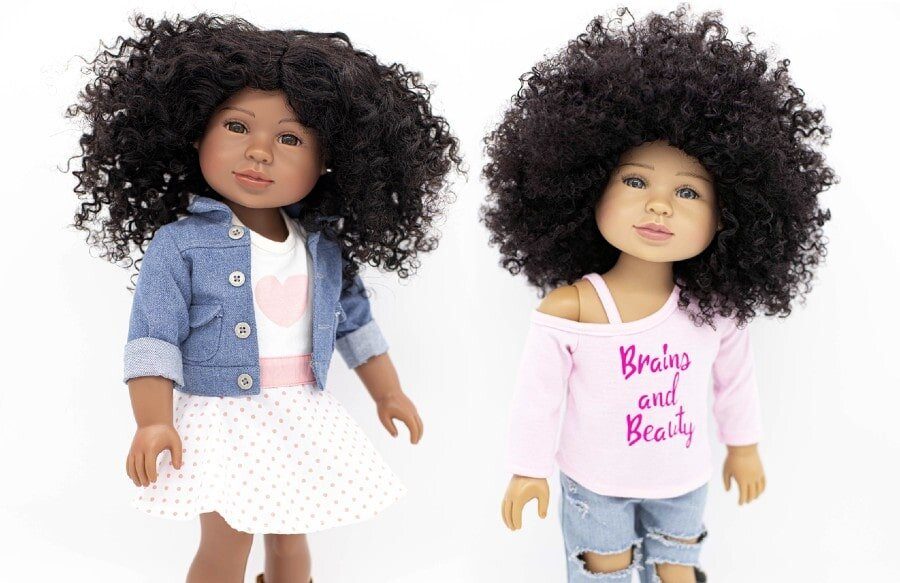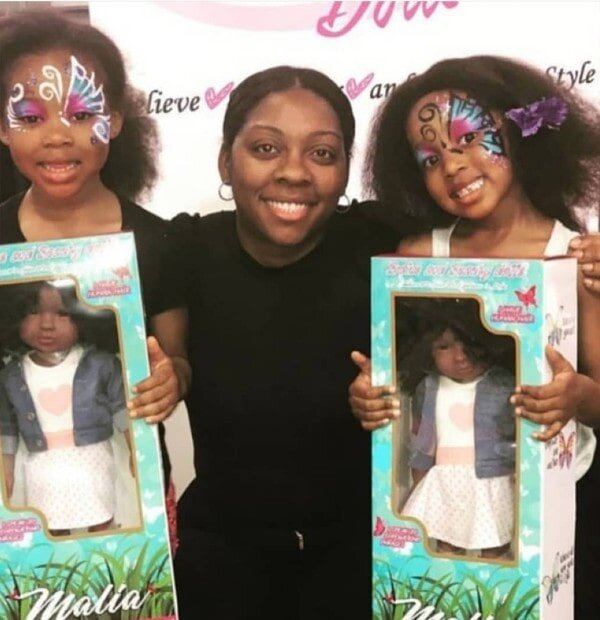Looking for Black Talking Dolls? This Line Is Perfect for You
Niya Dorsey’s Brains & Beauty Dolls say 20+ empowering affirmations.

A doll is never really just a doll: It’s often a plastic landmine that, once tripped, can lead to hard conversations about race, colorism, body image, and more.
It’s a lot for those tiny shoulders to carry—and even more for parents to try to explain to their kids.
That’s why many moms make an effort to only buy Black dolls. We know the results of “The Doll Test”: white dolls can reinforce messages of self-hatred in Black and brown children, and children of all races are biased toward lighter skin. (Sadly, a 2010 recreation of the study showed not much has changed… and remember the viral video of Ariyonna, a 4-year-old girl with deep brown skin who broke the Internet’s heart when she said “I’m so ugly”?)
Niya Dorsey had all of this in mind when she created Brains & Beauty Dolls in 2017. The line of 18” Black talking dolls —Malia (named after her daughter) and Khari—speak more than 20 different empowering phrases, including “You can be whatever you want to be” and “You are strong.”
“I wanted to create each doll with a set of powerful phrases, designed to teach our girls to rise above stigmas and criticism, and to love themselves for who they truly are,” the Sicklerville, New Jersey-based mom of two explains on her website.
“Children that hear positive affirmations and have positive role models tend to thrive in their self-awareness and use that energy to prosper,” she continues. “They are usually confident, strong, and follow their dreams.”
Niya’s following her dreams, too. But, as she explains in an interview with mater mea, it can be hard. Along with juggling the demands of being a mom and wife, she’s also navigating the ups and downs of trying to get her Black talking dolls in households everywhere.
Here Niya talks openly about finding a manufacturer in China, dealing with price-sensitive customers (her Black dolls retail for $90), and staying true to her vision.
The interview was edited for length and clarity.

What was your relationship like with dolls before you started your company?
I had some Barbies. I had a Baby Born. She was a bald-headed brown doll, she would pee-pee and poop when you fed her. I had another brown doll: She was about 18″, she had a heart on her cheek. She was a pretty brown, but she had gold hair.
How did that make you feel as a kid?
Honestly, I can’t remember to even say I felt a way because I had mostly Black dolls. The difference is all the Black dolls’ hair was straight. It was never thick and kinky like mine. (Laughs) I guess I can say I used to be like “Ma, can you straighten my hair so it can be nice like that?”
How did your daughter inspire your company?
It was between her and God. My daughter was only 1 month old. Prior to that, I actually wanted to have my own clothing line. I never really thought about dolls.
I was playing with her, and at that moment I thought, “We need to create a doll.”
I picked up the phone and called my aunt. “Listen: What would you think if I created a doll that represents our girls of color, but made it as realistic as possible?”
She said, “You may be on to something. You have dolls with brown skin, but their features are not too much like ours.”
It took some time. I Googled, Googled, Googled and called different people to try and find manufacturers. I ended up finding one: I sent a photo of my daughters’ face—she was about 2-3 months at that time. I gave it to the manufacturer and they were like, “Oh yeah, we can sculpt a doll like this.”
But I also wanted the dolls to have real human hair; a lot of dolls now you can’t style their hair. The manufacturer was like, “Um, excuse me? We don’t have that. People don’t do this.”
So I had to find another manufacturer that had real human hair, and have them coordinate with the doll manufacturer.
For the full story visit mater mea by clicking here.
In a series called “Black Mom Owned,” mater mea highlights Black mom-owned businesses to support (Team Buy Black), like Brains & Beauty Dolls, a line of Black talking dolls. Would you like to be featured? Fill out this intake form to be considered.
This story by Tomi Akitunde first appeared on mater mea.


